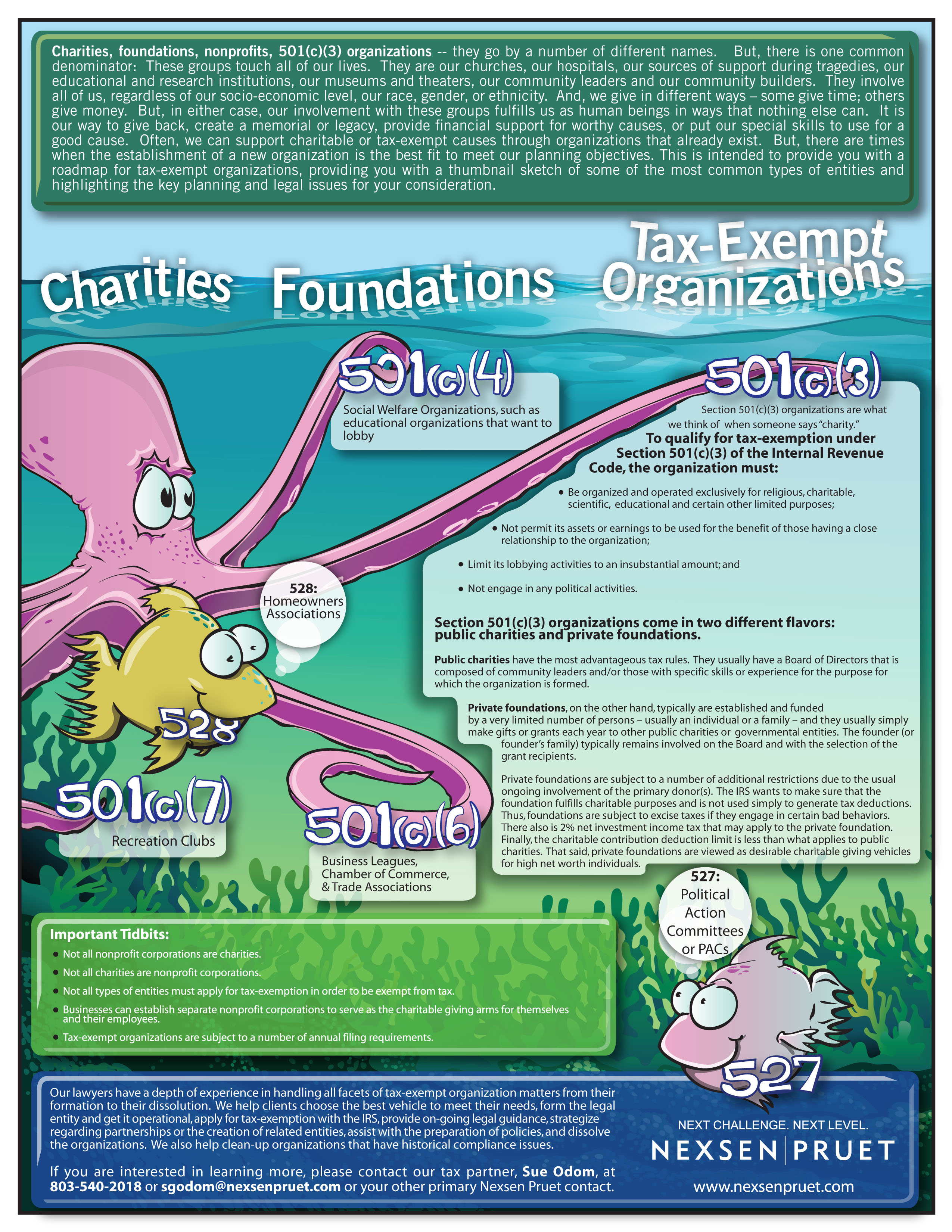
On "Giving Tuesday" 2015, Nexsen Pruet attorney Sue Odom shares some insight into the structure and arms of the organizations that touch our lives - and the legal issues involved. These organizations can be classified as a 501(c)(3), 501(c)(4), 501(c)(6), 501(c)(7), 527 or 528.

Charities, foundations, nonprofits, 501(c)(3) organizations -- they go by a number of different names. But, there is one common denominator: These groups touch all of our lives. They are our churches, our hospitals, our sources of support during tragedies, our educational and research institutions, our museums and theaters, our community leaders and our community builders. They involve all of us, regardless of our socio-economic level, our race, gender, or ethnicity. And, we give in different ways – some give time; others give money. But, in either case, our involvement with these groups fulfills us as human beings in ways that nothing else can. It is our way to give back, create a memorial or legacy, provide financial support for worthy causes, or put our special skills to use for a good cause. Often, we can support charitable or tax-exempt causes through organizations that already exist. But, there are times when the establishment of a new organization is the best fit to meet our planning objectives. This is intended to provide you with a roadmap for tax-exempt organizations, providing you with a thumbnail sketch of some of the most common types of entities and highlighting the key planning and legal issues for your consideration.
Section 501(c)(3)
Section 501(c)(3) organizations are what we think of when someone says “charity.”
To qualify for tax-exemption under Section 501(c)(3) of the Internal Revenue Code, the organization must:
- Be organized and operated exclusively for religious, charitable, scientific, educational and certain other limited purposes;
- Not permit its assets or earnings to be used for the benefit of those having a close relationship to the organization;
- Limit its lobbying activities to an insubstantial amount; and
- Not engage in any political activities.
Section 501(c)(3) organizations come in two different flavors: public charities and private foundations.
Public charities have the most advantages tax rules. They usually have a Board of Directors that is composed of community leaders and/or those with specific skills or experience for the purpose for which the organizations is formed.
Private foundations, on the other hand, typically are established and funded by a very limited number of persons – usually an individual or a family – and they usually simply make gifts or grants each year to other public charities or governmental entities. The founder (or founder’s family) typically remains involved on the Board and with the selection of the grant recipients.
Private foundations are subject to a number of additional restrictions due to the usual ongoing involvement of the primary donor(s). The IRS wants to make sure that the foundation fulfills charitable purposes and is not used simply to generate tax deductions. Thus, foundations are subject to excise taxes if they engage in certain bad behaviors. There also is 2% net investment income tax that may apply to the private foundation. Finally, the charitable contribution deduction limit is less than what applies to public charities. That said, private foundations are viewed as desirable charitable giving vehicles for high net worth individuals.
Section 501(c)(4)
Social Welfare Organizations, such as educational organizations that want to lobby
Section 501(c)(6)
Business Leagues, Chamber of Commerce, & Trade Associations
Section 501(c)(7)
Recreation Clubs
Section 527
Political Action Committees or PACs
Section 528
Homeowners Associations
Important Tidbits:
-
Not all nonprofit organizations are charities
-
Not all charities are nonprofit corporations
-
Not all types of entities must apply for tax-exemption in order to be exempt from tax
-
Businesses can establish separate nonprofit corporations to serve as the charitable giving arms for themselves and their employees
-
Tax-exempt organizations are subject to a number of annual filing requirements"